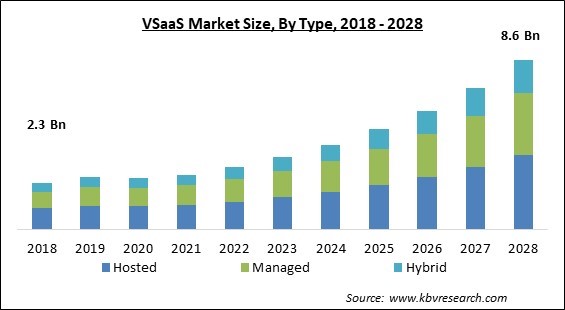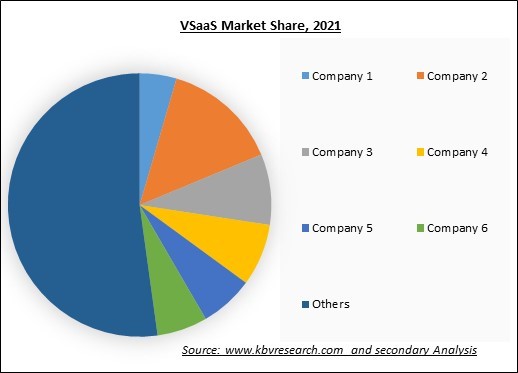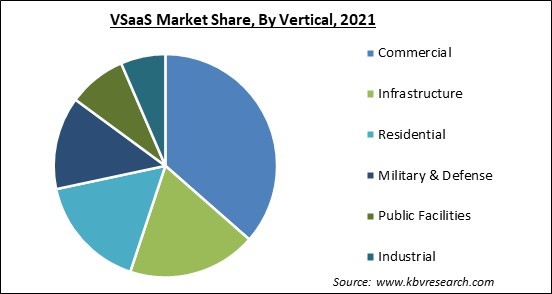The Global VSaaS Market size is expected to reach $8.6 billion by 2028, rising at a market growth of 18.2% CAGR during the forecast period.
VSaaS is a cloud-based surveillance service which allows users to operate video surveillance devices remotely for a more inventive and scalable security solution. Secure remote monitoring features, real-time updates, a substantially reduced footprint, and full control of surveillance data on a unified platform are all advantages of VSaaS over conventional on-premise Video Management Systems (VMSs).

Businesses can reimagine their surveillance systems using VSaaS without having to worry about unexpected maintenance costs or pricey system changes. The analytics and machine-learning algorithms in VSaaS are powered by the newly updated artificial intelligence technologies, providing important insights and actionable feedback for the organization. Furthermore, VSaaS is a far more cheap solution than conventional on-premise VMSs because to fewer hardware and software needs, lower energy consumption, and complete system scalability.
Numerous commercially hosted Video Management Systems employ an on-site appliance that enables users to connect and record a variety of current third-party cameras. Such open VSaaS providers provide customers the freedom to choose from a variety of hardware vendors or just use current surveillance hardware to create a security solution that meets corporate needs and budget. Although, some VSaaS providers only provide closed video access through proprietary gear, necessitating the replacement of any current video surveillance hardware in order to switch to this service model.
To mitigate the cost of financing a completely different system, these VSaaS providers would frequently provide to rebuild the entire system at a lesser cost. While the low initial cost of such plans may appear tempting, they might be overly restrictive and provide little to no flexibility in terms of hardware selections that best meet business needs. In many circumstances, whatever money saved initially on these services is wasted tenfold over time.
This is owing to supply chain interruptions and cross-border trade restrictions, which have caused delays in the delivery of hardware components, primarily cameras, especially from China. Due to the limited operations of companies or facilities, COVID-19 spread to a variety of industries, including automotive, electronics, and hospitality. In addition, many governments postponed new infrastructure projects, which had a negative impact on the security equipment and software (including VSaaS) market in 2020. The market has begun to recover, and demand for select products from sectors like healthcare, smart cities, retail, and public facilities has recovered, as video surveillance systems are critical in combating COVID-19.
One of the primary drivers of VSaaS market growth is the growing demand for actual surveillance data throughout commercial and infrastructure sectors. End customers such as retail establishments, manufacturing sites, corporations, warehouses, and banks need real-time remote monitoring on every device at any time to notice unexpected events on their premises due to security concerns and technological improvements. Users with different business locations also require real-time and remote access to surveillance data in order to keep an eye on the location from afar.

The leading players in the market are competing with diverse innovative offerings to remain competitive in the market. The below illustration shows the percentage of revenue shared by some of the leading companies in the market. The leading players of the market are adopting various strategies in order to cater demand coming from the different industries. The key developmental strategies in the market are Product Launches and Partnerships & Collaborations.
The growing prevalence of do-it-yourself (DIY) video surveillance for home security, along with the increasing use of smart devices, is providing attractive potential for VSaaS service providers in the market. Smartphone prevalence has increased in recent years in China, the United States, the United Kingdom, India, and Japan, owing to lower prices, technological breakthroughs, and enhanced usefulness. The growing use of smart devices has opened up new prospects for VSaaS providers. By providing VSaaS compatible with various devices, service providers can expand their market share. Over the years, global infrastructure investments have increased.
The Federal Information Security Management Act (FISMA) in the United States and the General Data Protection Regulation (GDPR) in Europe have been enacted in response to growing privacy and security concerns. These rules are being imposed on VSaaS providers in order to prevent the misuse of a user's personal data, particularly in the area of face recognition technology. Furthermore, as IT companies become more aware of the dangers of personal data bridges, they are becoming more cautious when picking a VSaaS solution. Along with that, governments are widely investing in strengthening the security systems across the world due to the rising incidents like terrorist attacks.
Based on Vertical, the market is segmented into Commercial, Infrastructure, Residential, Military & Defense, Public Facilities, and Industrial. Infrastructure segment recorded a substantial revenue share in the VSaaS market in 2021. The market is predicted to develop due to rising demand for VSaaS solutions in the public spaces, transportation, and municipal surveillance segments. New prospects for VSaaS providers will arise as a result of favourable government initiatives to establish smart city projects. Several countries, including China, India, and South Korea, are heavily investing in the development of smart cities.

Based on Type, the market is segmented into Hosted, Managed, and Hybrid. Hosted VSaaS segment acquired the largest revenue share in the VSaaS market in 2021. The significant market share can be attributed to rising VSaaS use in the residential, SMB, and retail sectors, as well as increased smart city penetration in various regions. Furthermore, as fast internet speed is one of the essential criteria of service providers and customers, growing smartphone penetration, commercialization of 5G services, and affordability of high Internet are assisting the market for hosted VSaaS to expand.
Based on the Application, the VSaaS Market is fragmented into IT & Telecommunication, Energy & power, Automotive, Consumer Electronics, Medical devices, Aerospace & Defense, Industrial, and Others. The Automotive segment procured a substantial revenue share in the VSaaS Market in 2021. Along with security concerns, managing more sophisticated electronic systems and industry standards like automotive ethernet add to the demands placed on-vehicle testing. Without the development of inventive automobile test solutions that facilitate the transfer of road tests to the test rig for reproducibility and test automation, such difficulties would be insurmountable.
Based on the Connectivity Technology, the VSaaS Market is classified into Wi-Fi, Bluetooth, 2G/3G, 4G/LTE, and 5G & Others. The Wi-Fi segment procured the highest revenue share in the VSaaS Market in 2021. It is important to perform wireless testing of the wi-fi network, in order to ensure the safety of complete path of WLAN network. The aim is to identify and eliminate any kind of vulnerabilities in the wi-fi network. Therefore, the wireless testing has great prospects in Wi-Fi network.
| Report Attribute | Details |
|---|---|
| Market size value in 2021 | USD 2.7 Billion |
| Market size forecast in 2028 | USD 8.6 Billion |
| Base Year | 2021 |
| Historical Period | 2018 to 2020 |
| Forecast Period | 2022 to 2028 |
| Revenue Growth Rate | CAGR of 18.2% from 2022 to 2028 |
| Number of Pages | 181 |
| Number of Tables | 290 |
| Report coverage | Market Trends, Revenue Estimation and Forecast, Segmentation Analysis, Regional and Country Breakdown, Market Share Analysis, Companies Strategic Developments, Company Profiling |
| Segments covered | Type, Vertical, Region |
| Country scope | US, Canada, Mexico, Germany, UK, France, Russia, Spain, Italy, China, Japan, India, South Korea, Singapore, Malaysia, Brazil, Argentina, UAE, Saudi Arabia, South Africa, Nigeria |
| Growth Drivers |
|
| Restraints |
|
Based on the Region, the VSaaS Market is analyzed in North America, Europe, Asia Pacific, and LAMEA. North America emerged as the leading region in the VSaaS Market with the largest revenue share in 2021. This is due to the acceptance of new technologies throughout various industries. Advanced technologies like IoT and M2M are likely to heavily rely on 5G networks. Owing to its simultaneous connectivity to numerous devices and low latency, the 5G network is regarded as essential for smart cities and industrial automation, which enhances system performance. Businesses are working to create 5G technologies
Free Valuable Insights: Global VSaaS Market size to reach USD 8.6 Billion by 2028
The major strategies followed by the market participants are Partnerships. Based on the Analysis presented in the Cardinal matrix; Keysight Technologies, Inc. is the major forerunner in the VSaaS Market. Companies such as Intertek Group PLC, DEKRA SE and Anritsu Corporation are some of the key innovators in VSaaS Market.
The market research report covers the analysis of key stake holders of the market. Key companies profiled in the report include Johnson Controls International PLC, Honeywell International, Inc., Robert Bosch GmbH, Axis Communications AB (Canon, Inc.), Comcast Corporation, Arlo Technologies, Inc., Vivint Smart Home, Inc., ADT, Inc. (Apollo Global Management, Inc.), Genetec, Inc., and Pacific Controls Systems.
By Vertical
By Type
By Geography
The VSaaS market size is projected to reach USD 8.6 billion by 2028.
Rising demand for real-time surveillance data are driving the market in coming years, however, Strict government rules about privacy and data security limited the growth of the market.
Johnson Controls International PLC, Honeywell International, Inc., Robert Bosch GmbH, Axis Communications AB (Canon, Inc.), Comcast Corporation, Arlo Technologies, Inc., Vivint Smart Home, Inc., ADT, Inc. (Apollo Global Management, Inc.), Genetec, Inc., and Pacific Controls Systems.
The expected CAGR of the VSaaS market is 18.2% from 2022 to 2028.
The Commercial segment acquired maximum revenue share in the Global VSaaS Market by Vertical in 2021, thereby, achieving a market value of $2.87 billion by 2028.
The North America market dominated the Global VSaaS Market by Region in 2021, and would continue to be a dominant market till 2028; thereby, achieving a market value of $3.03 billion by 2028.
Our team of dedicated experts can provide you with attractive expansion opportunities for your business.

